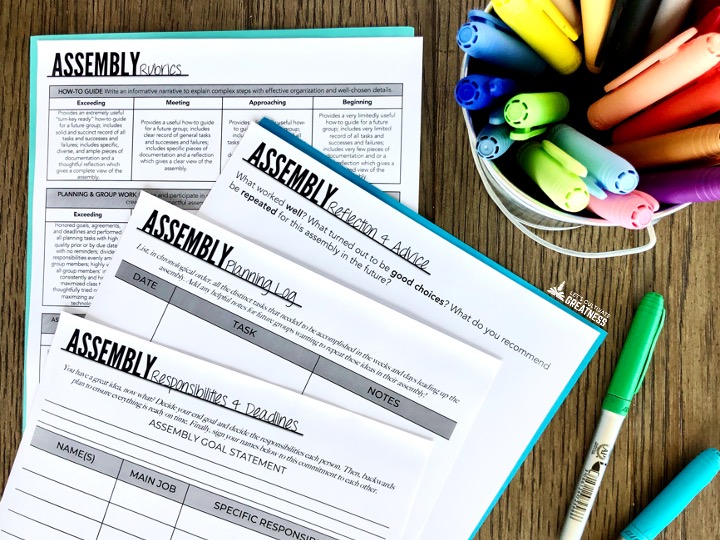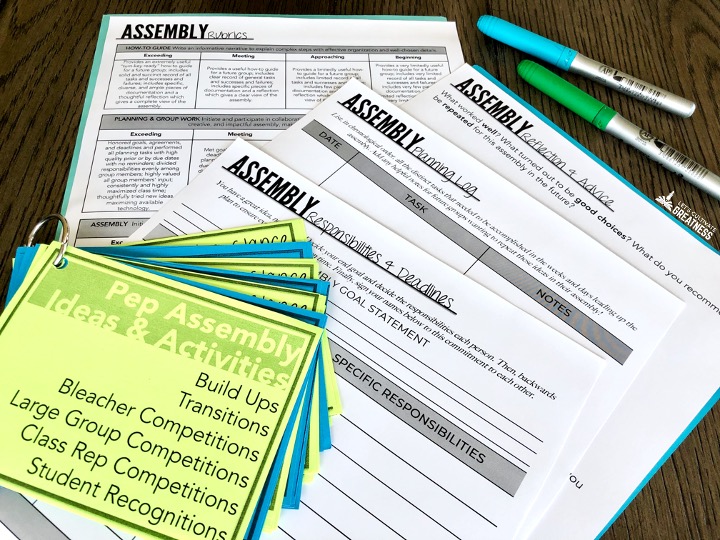“It takes a great assembly to be better than no assembly at all.”
This our mantra whenever my student leaders get into assembly planning mode. I shamelessly borrowed and tweaked it from what a former principal always said about meetings, and it’s created a whole new perspective for how we think of our job as we plan a worthwhile assembly.
If my student leaders are interrupting class time, it not only better be for good reason, but it also better be done well.
It took me a few years to figure out the right mix of maintaining control as the advisor and giving students autonomy. I have learned both are necessary to ensure students’ voice and energy carry the project through, but that at the same time nothing major gets overlooked.
The most important part of our system is setting up clear deadlines and outcomes at each step in the timeline. This eliminates so many problems and allows us to host impactful and well-thought-out assemblies for the rest of the student body.
A huge part of our success is using backwards planning, which in itself is only possible with the master calendar we set up at the beginning of the year. I have a whole blog post dedicated to this essential component, but in short, we not only pencil in all the assemblies for the year (easy when most are pretty predictable), but also the planning reminders, like when we need to start brainstorming, when the dress rehearsal needs to be, and to block off the class period after to debrief.
Here is my tried-and-true system for how to plan a school assembly:
3 to 4 Weeks Prior: Brainstorm & Form Committee
First, I like to have the whole group brainstorm ideas for an upcoming assembly before a committee is even formed.
I have found we have much better assemblies, ones that are more inclusive and creative, when all students pitch in their ideas. Only a handful will make up the committee that determines the final choices, but starting that small group off with input from a wider range of voices sets the assembly up for better success.
This quick brainstorm session gets ideas on paper, talking about big goals or wonders for trying something different. It’s nothing formal—sometimes we make broad decisions and sometimes it’s really just a messy list. At the end of our collective brain dump, I’ll ask for a few students to create an ad hoc committee to be the core planners.
This is also when the committee will review the files from previous years’ assemblies to look over. These files include all the artifacts, like scripts and responsibility lists, as well as advice for future assemblies and a running list of ideas not yet tried. Students create a records file using my collection of planning forms and templates for any assembly and larger project we do, not only to help them be organized during the project, but also to serve as a valuable tool for future years.
So instead of trying to recall which poem we read at last year’s Veterans’ Day assembly or what games were the crowd favorites at last year’s spirit assemblies, we just can grab the capsule files from previous years.

1 to 3 Weeks Prior: Finalize the Details
Causally check in with your students during those planning weeks.
I’ve learned this is when students want a degree of independence, but I still make sure to be aware of what they are working on. Sometime during the week before the assembly, have students walk you through the details. This is when I ask more detailed “what about” or “what if we” questions to make sure their ideas pass that “better than no assembly” test.
This is also when we really scrutinize the timeline of the events planned. I have found that students struggle to accurately estimate the amount of time, both too short and too long, that things will take and we need to adjust accordingly. This is especially noticeable with spirit assemblies, when there are a lot of changing segments.
Because of this, a requirement of mine is to have a backup game or activity planned, just in case we need to stall during a technical difficultly or end up with a few minutes left over at the end.
Lastly, now is when students need to reach out to anyone (or send a follow-up confirmation) they will need help from on the day of the assembly, like your school’s tech person to help with speakers.
1 to 2 Days Prior: Submit for Approval & Practice
If an assembly is on a Friday, make Wednesday the due date for all scripts, props, and supplies.
This due date is also when we complete a dress rehearsal. There was a huge difference in our stress levels when I began implementing this hard 48-hour-out deadline. It let us run through everything mentally as we check off supplies as well as practice the order of events.
We have everything out and ready—electronic equipment checked and charged, extra copies of scripts printed, a list of students who have committed to stay a couple minutes after to clean up. Everything possible we can think of.
This also gives us more practice time with the microphones and our public speaking skill work as we complete the dress rehearsal.
The Day Of: Host a Great Assembly
It’s important to let your student leaders shine as they host their assembly.
In some schools, the principal or advisor seems to MC the event more often than the students. I am rarely on the mic, instead letting the students take center court. I have taken on more of the role of a stagehand, making sure to whisk away what’s coming off stage and making sure the next thing is lined up.
I do try to track timestamps of each segment to help us debrief on pacing the next day, especially during spirit assemblies when we can often feel rushed to get to everything or find ourselves with time at the end.
After the assembly, we generally just stash everything back into my classroom to properly put away the next day.
The Day After: Debrief & Clean Up
The first thing we do during the class after an assembly is finish cleaning everything up—return borrowed items, dismantle large items, double-check the electronics before putting back into storage, etc. I save all this for the next day so the burden isn’t on just one or two students (or just me) who stayed late after the assembly ended. It allows the whole group to share in the responsibility and awareness that they are all the hosts, not the guests.
This is also when we make and sign any thank you cards to special guests, speakers, or people who helped with the event.
And just like with brainstorming, it’s important for the whole group to debrief together. We share positives and constructive comments for the next time. This collective feedback is invaluable since the student who was MC-ing the whole thing and a student in the bleachers had two different experiences. Students record these reflections and ideas in the capsule file, along with scripts, photos, and all the planning forms.
These stapled-together-and-filed-away capsule files are a triple win. Students perform so much better by creating this paper trail along the way, they give me something tangible to meaningfully grade, and they serve as starting blocks for next years’ students as they begin planning their own assembly.
If you’d like to take the chaos out of planning your next assembly, you’ll definitely want to check out my Ultimate Assembly Planning Kit, which includes all the brainstorming, planning, and debriefing forms you’ll need to host a great event without all the headaches. Plus, included in the kit is a flip deck of 40 spirit assembly game ideas to make your events inclusive and positive for all students.

Feature image credit: Keira Burton





